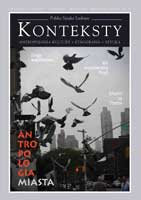Genius loci a zachowania przestrzenne i style życia mieszkańców Szmulek
Genius Loci and the Spatial Behaviour and Lifestyle of the Residents of Szmulki
Author(s): Iwona Anna OliwińskaSubject(s): Anthropology
Published by: Instytut Sztuki Polskiej Akademii Nauk
Keywords: anthropology; Genius Loci; Szmulki
Summary/Abstract: The district of Praga and Szmulowizna had been treated for four centuries as a distinctive and inferior part of town. Nonetheless, this fragment of Warsaw possesses its own genius loci. It served as a haven for people not welcome on the left bank of the Vistula (such as runaway servants, thieves, bigamists, the poor and the homeless, petty artisans and shopkeepers, and the Jews). It was also chosen by representatives of the gentry, who treated the quarter as a sui generis hinterland, and used their residences only when they came to meet the king. Today, Praga is the destination not only by people evicted from the other bank of the Vistula, but the place of residence of artists and young university graduates. In the past, it was also chosen for industrial enterprises not fit for the elegant capital (charnel houses, tanneries, joiners’ and dye shops, wire works, steel mills, etc.). For centuries, Praga was the site of flourishing trade and crafts. It was, and still is, full of street bazaars, open-air stalls, assorted small shops and workshops, where one could purchase or repair everything. Here, time seems to run a less hurried course, almost resembling that of a small provincial town. This particular section of Praga North also features a different architecture, whose development and form were influenced by the owners of Praga and Szmulowizna and the partitioning and local authorities. For hundreds of years, attention had not been paid to the well-balanced progress and development of Praga and Szmulowizna, regarded as an unattractive part of Warsaw of little interest to investors. Not until the 1990s was the appeal of the district, with its pre-war houses and a so-called ambiance, actually noticed. This was the period of the revitalisation of the old and neglected town houses (although only in select quarters). The history, folklore and brogue of Praga were promoted. The authorities of the district created opportunities for the newly settled artists, transforming industrial space into its cultural counterpart, and approving cooperation with local social partners.
Journal: Konteksty
- Issue Year: 2008
- Issue No: 03-04
- Page Range: 237-249
- Page Count: 13
- Language: Polish
- Content File-PDF

